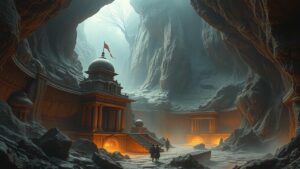Exploring the “Temple of the Hidden Flame,” where ancient fire rituals remain unexplained.
Exploring the “Temple of the Hidden Flame”: Unraveling Ancient Fire Rituals
Deep in the heart of the Andes Mountains lies the enigmatic Temple of the Hidden Flame, a site where ancient fire rituals once flourished, leaving behind an air of mystery that has captivated researchers and explorers alike. Located near the village of Koyllurit’i in Peru, this temple is believed to date back to the Inca civilization and possibly even earlier cultures. In this article, we will delve into the significance of the temple, its historical context, and the enduring mysteries surrounding its fire rituals.
A Historical Overview
The Temple of the Hidden Flame is believed to have been constructed around the late 15th century, coinciding with the peak of the Inca Empire. At that time, the Incas worshipped Inti, the Sun God, and fire played a crucial role in their spiritual and cultural practices. The temples exact purpose remains unclear, but archaeological findings suggest it was a significant site for rituals related to the veneration of fire.
Recent excavations and studies, such as those conducted by the University of Cusco in 2019, have uncovered ceremonial artifacts, including pottery used in offerings and remnants of ancient fires. These findings indicate that the temple was not merely a place of worship but also a center for community gatherings, where rituals were performed to honor both the gods and the elements.
The Significance of Fire in Ancient Rituals
Fire has always held a profound meaning across various cultures, symbolizing purification, transformation, and the connection between the earthly realm and the divine. In the context of the Temple of the Hidden Flame, fire was integral to the rituals performed by the Incas and their ancestors.
- Purification: Fire was often used in rituals aimed at cleansing participants and objects, allowing them to connect more deeply with the spiritual forces at play.
- Offers to Deities: The Incas would make offerings to their gods through fire, believing that smoke carried their prayers to the heavens.
- Symbol of Life: Fire represented the suns life-giving energy, reinforcing the connection between nature and the communitys survival.
The Unexplained Aspects of the Temple
Despite extensive research, several aspects of the Temple of the Hidden Flame remain a puzzle:
- Ritual Procedures: The specific methods and meanings behind the rituals conducted at the temple are still largely unknown. How were the fires ignited? What materials were used in the rituals?
- Societal Structure: The role of the priesthood and the societal hierarchy within this ritual context remains speculated but unconfirmed.
- Spiritual Beliefs: Many aspects of the belief system surrounding these fire rituals have yet to be fully documented, leaving gaps in our understanding of the culture.
Modern-Day Implications
The Temple of the Hidden Flame continues to draw tourists, archaeologists, and historians, generating interest and debate over ancient practices. Not only does it serve to educate visitors about Incan culture, but it also highlights the need for preservation initiatives due to potential environmental threats and tourism impact.
Plus, the temples location near Koyllurit’i is famous for its annual pilgrimage during the Qoyllur Rit’i festival, attracting thousands of pilgrims who still practice traditions rooted in ancient worship.
Conclusion & Actionable Takeaways
The Temple of the Hidden Flame stands as a testament to the complexities of Inca spirituality and its intricate relationship with fire. While significant insights have been gained, the ancient rituals remain shrouded in mystery, inviting further exploration and scholarly attention.
For those interested in learning more about this captivating site and its rituals, consider the following actions:
- Plan a visit to Koyllurit’i during the Qoyllur Rit’i festival to experience the blend of ancient tradition and modern spirituality.
- Support archaeological efforts and preservation projects aimed at protecting the temple from natural and human-induced damages.
- Engage with academic studies and literature surrounding Incan culture to deepen your understanding of their ancient rituals and beliefs.



